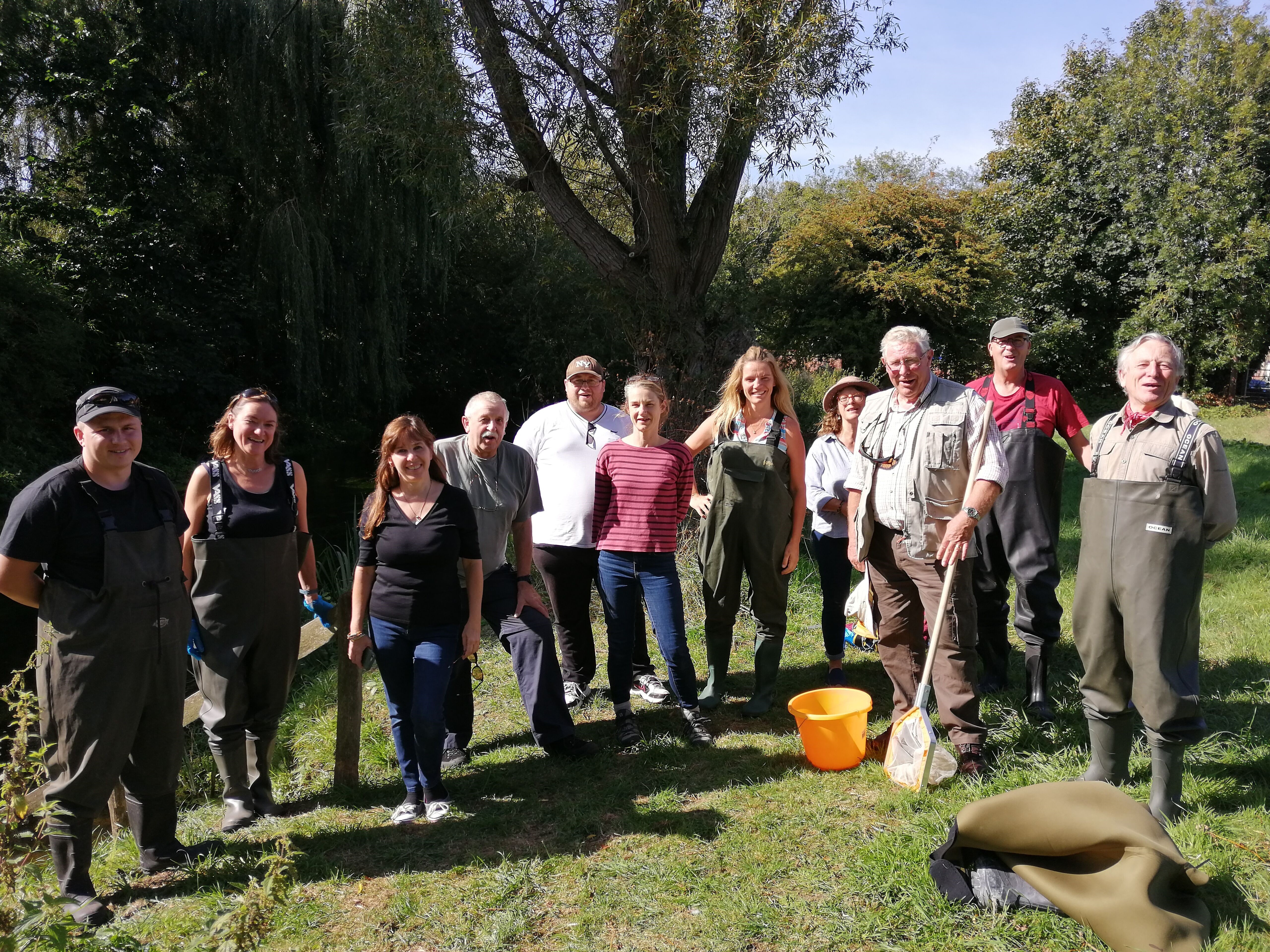East Kent
- Catchment HostSouth East Rivers Trust
- River Basin DistrictSouth East
- Management CatchmentStour
- Management Catchment ID3087
Catchment partnership vision
We will work together to ensure a continual improvement in the health of waterbodies in East Kent. We will collaborate with others to ensure that we minimise the impact of development, population growth and a changing climate on our waters. Actions to improve waterbody health will ensure wider benefits for society, recognising the vital associated ecosystem services. This includes:
- more wildlife habitat
- safeguarded water resources - surface and ground water; less flood risk
- sustainable farming
- water based economic activity, such as tourism, better recreation opportunities, such as access, fishing, boating, cleaner bathing beaches and shellfish areas
- a better chance to adapt to climate change.

Related websites
Find out more about the activities and ambitions of this catchment partnership and how you can get involved to help improve the water environment in the catchment.
Catchment challenges
Current challenges identified by partnership

Pollution from towns, cities and transport
Proposed development across the catchment will exacerbate existing road and urban run off pollution

Pollution from waste water
Increased housing will further exacerbate the significant levels of phosphate coming from Waste water treatment works

Changes to the natural flow and water levels
Inability of catchment to catch/ hold water in poor landscape and over abstraction from agriculture and further development
Wider water environment challenges identified by partnership
Nature Recovery, protect and enhance rare habitats including chalk streams
Priority habitat chalk river and internationally significant wetland, impacted by urban & rural pollution, over abstraction & physical modification
Reduce storm overflows and drainage system incidents
Significant pollution from storm over flows impact protected habitats, bathing water, shellfish industry and biodiversity
Protect and restore healthy soils and nutrient balance
Important area for agriculture, important to address poor soils and run off, excessive nutrients as polluting catchment waters
Build environmental resilience and adaptation to climate change
Water stressed catchment due to increased abstraction through development, agriculture and general public overuse
Removing plastics/litter from the water environment
Litter a big problem at catchment, national and international level
Connecting communities with nature
Important to get more people involved in their catchment to reduce water, waste and pollution
Future challenges predicted by partnership

Pollution from towns, cities and transport
The Catchment is in an area experiencing lots of building growth alongside water pollution already coming from urban areas and roads

Changes to the natural flow and water levels
East Kent is a water stressed county and renaturalisation of the rivers through easement of obstructions and river/ floodplain restoration is vital to protect our water environment

Pollution from agriculture and rural areas
Our waters are struggling with pollution - impacting on international wetlands and drinking water, we have lots of intensive agriculture and will be tackling these pollution issues
Future challenges predicted by Environment Agency
Future challenges in 2050
- Pollution from Towns Cities and Transport
- Invasive Non-native Species
- Changes to the Natural Flow and Water Levels
Emerging challenges
- Pollution from Towns Cities and Transport
- Changes to the Natural Flow and Water Levels
- Pollution from waste water
Partnership success highlights 2016 to 2021
'Our Stour' is a community project about enjoying and improving the rivers and streams of the Stour Valley. This project has been ongoing for 3 years and has created a group of over 60 trained volunteer wardens monitoring different stretches of the catchment. Huge quantities of rubbish have been removed from the river in regular in-channel litter picks, regular river fly monitoring is occurring on 15 sites - https://www.kentishstour.org.uk/major-projects-2/our-stour-project-page. The project has secured funding for another 3 years. Obstructions to fish passage in the Stour and tributaries have partly been addressed with a step-pool fish pass in Ashford, removal of weir on the Aylesford stream and a lariner fish pass at Chartham. A lariner fish pass in the Stour near Wye has recently been completed at a complete obstruction, a fifth in the river Dour is ongoing. Work has also started on making a low weir passable for all species at Canterbury in main river. An assessment has been made of the majority of structures in the River Stour, by South East Rivers Trust to ascertain impacts on fish populations, this will be completed within the year and will lead to more removals of in-channel obstacles. Community engagement is ongoing on main river in Ashford. Invasive species - particularly Himalayan balsam is regularly tackled in catchment.

Partnership development plans
In the coming years we:
- hope to see an increase in engagement with communities who live on or near the river
- will have a greater emphasis on ensuring that the water courses are truly valued for the wider benefits they bring to society
- will seek opportunities to support net zero carbon ambitions
- will explore opportunities to participate in local Nature Recovery Networks
- will ensure the partnership has an understanding of the role we play in ensuring nutrient levels are sustainable.
Partnership priority actions and measures for 2022 to 2027
Confident
Tackling Invasive Non-native Species, particularly Himalayan balsam, Japanese knotweed, azolla
- Reason for measure
- Control or manage invasive non-native species
- Delivery mechanism
- WEIF Water Environment Improvement Fund
- Location
- Great Stour between A2 and West Stourmouth Wingham and Little Stour Great Stour between Ashford and Wye Great Stour between Wye and A2 Ash Level
Confident
ProWater - trialling techniques for improved landscape resilience to drought
- Reason for measure
- Manage modified habitats
- Delivery mechanism
- EU funding
- Location
- Stour Lower
Confident
Our Stour Community Engagement - increased monitoring of river ecology, pollution and litter removal
- Reason for measure
- Control or manage urban diffuse pollution
- Delivery mechanism
- Other local funding
- Location
- Great Stour between A2 and West Stourmouth Great Stour between Ashford and Wye Great Stour between Wye and A2
Confident
Halfords Fish Pass, River Dour
- Reason for measure
- Mitigate the impacts on ecology from physical modifications in modified waters
- Delivery mechanism
- WEIF Water Environment Improvement Fund
- Location
- Dour from Kearsney to Dover
Confident
Enhancement/no deterioration measures in 2020-2025 Water Industry National Environment Programme
- Reason for measure
- Control or manage point source discharges
- Delivery mechanism
- Confirmed water industry national environment programme 2020-2025
- Location
- Stour
Confident
removal of physical obstructions in catchment
- Reason for measure
- Mitigate the impacts on ecology from physical modifications in modified waters
- Delivery mechanism
- None identified
- Location
- Great Stour between A2 and West Stourmouth Great Stour between Ashford and Wye Great Stour between Wye and A2
Less certain
Farm cluster group habitat assessments to encourage increased biodiversity/ resilient land management practices
- Reason for measure
- Control or manage rural diffuse pollution
- Delivery mechanism
- Other local funding
- Barriers to delivery
- Habitat assessments confirmed, improvements dependent on SFI/ELMS mechanisms for funding farmers
- Location
- Lampen Stream
Less certain
East Kent White Claw Crayfish Strategy will address deterioration in river habitats
- Reason for measure
- Mitigate the impacts on ecology from physical modifications in modified waters
- Delivery mechanism
- Other local funding
- Barriers to delivery
- increased funding and landowner buy in
- Location
- Upper Great Stour Sarre Penn and River Wantsum East Stour Great Stour between Wye and A2
Less certain
input into discussions around development mitigation as regards Nutrient neutrality
- Reason for measure
- Control or manage urban diffuse pollution
- Delivery mechanism
- None identified
- Barriers to delivery
- Decision making bodies understanding impacts of development and mitigation on catchment
- Location
- Great Stour between A2 and West Stourmouth Great Stour between Wye and A2
Wider water environment
Catchment Sensitive Farming advisors working throughout catchment
- Reason for measure
- Protect and restore healthy soils and nutrient balance
- Delivery mechanism
- Other Public funding
- Location
- Stour
Catchment Partnership contributors
Partners involved in the creation of this page and the actions of the partnership: